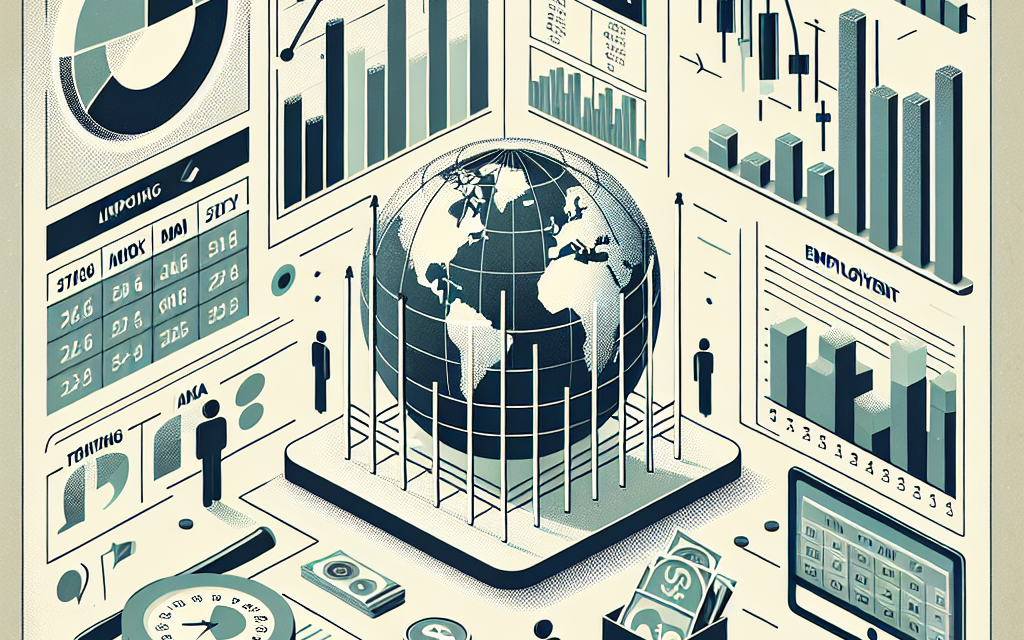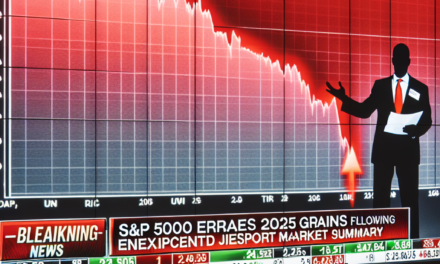“Stay Ahead: Key Economic Indicators and Bank Earnings to Watch This Week!”
Introduction
This week, investors and analysts will closely monitor key economic indicators and bank earnings reports that could significantly influence market trends and economic outlooks. Key economic indicators such as employment figures, inflation rates, and consumer spending data will provide insights into the health of the economy and potential shifts in monetary policy. Concurrently, major banks are set to release their quarterly earnings, offering a glimpse into the financial sector’s performance and resilience amid changing economic conditions. These reports will be critical for understanding the broader economic landscape and guiding investment strategies.
Consumer Price Index (CPI)
This week, one of the most significant economic indicators to monitor is the Consumer Price Index (CPI), which serves as a critical measure of inflation and reflects the average change over time in the prices paid by urban consumers for a basket of goods and services. The CPI is not only a vital statistic for economists and policymakers but also plays a crucial role in shaping the financial landscape, influencing everything from interest rates to wage negotiations. As such, understanding the implications of the CPI can provide valuable insights into the broader economic environment.
The CPI is released monthly by the Bureau of Labor Statistics and is closely watched by investors, analysts, and central banks alike. A rise in the CPI indicates that consumers are paying more for goods and services, which can signal inflationary pressures within the economy. Conversely, a stagnant or declining CPI may suggest deflation or a lack of demand, which can have its own set of economic challenges. This week’s CPI report is particularly important as it follows a period of heightened inflationary concerns, driven by various factors including supply chain disruptions, labor shortages, and shifts in consumer demand patterns.
Moreover, the implications of the CPI extend beyond mere numbers; they can influence monetary policy decisions made by the Federal Reserve. For instance, if the CPI shows a significant increase, it may prompt the Fed to consider tightening monetary policy by raising interest rates to curb inflation. On the other hand, a lower-than-expected CPI could lead to a more accommodative stance, with the Fed potentially maintaining or even lowering interest rates to stimulate economic growth. Therefore, market participants will be keenly analyzing this week’s CPI data to gauge the potential direction of future monetary policy.
In addition to its impact on monetary policy, the CPI also affects consumer behavior and business planning. When consumers perceive rising prices, they may adjust their spending habits, opting to save more or prioritize essential goods over discretionary spending. This shift can have a cascading effect on businesses, influencing their pricing strategies, inventory management, and investment decisions. Consequently, the CPI serves as a barometer not only for inflation but also for consumer confidence and economic health.
Furthermore, the CPI is often dissected into various components, such as food, energy, and core inflation, which excludes volatile items like food and energy prices. This breakdown allows analysts to identify specific areas of inflationary pressure and assess whether price increases are broad-based or concentrated in certain sectors. For instance, if energy prices are driving the CPI higher, it may indicate temporary supply issues rather than a fundamental shift in the economy. Understanding these nuances is essential for making informed investment decisions and anticipating market reactions.
As we await the release of this week’s CPI data, it is crucial to consider the broader economic context. Factors such as geopolitical tensions, changes in fiscal policy, and global supply chain dynamics can all influence inflation trends. Therefore, while the CPI is a key indicator to monitor, it should be viewed in conjunction with other economic data and trends. In conclusion, the upcoming CPI report will not only provide insights into current inflationary pressures but also set the stage for potential shifts in monetary policy and consumer behavior, making it a pivotal moment for investors and policymakers alike.
Gross Domestic Product (GDP)
This week, one of the most significant economic indicators to monitor is the Gross Domestic Product (GDP), which serves as a comprehensive measure of a nation’s overall economic activity. GDP reflects the total value of all goods and services produced over a specific time period, providing insights into the health of the economy. As such, it is a critical barometer for investors, policymakers, and economists alike. The release of GDP data can influence market sentiment, shape monetary policy decisions, and impact bank earnings, making it essential to pay close attention to the figures as they are announced.
In the context of the current economic landscape, analysts are particularly interested in the GDP growth rate, which indicates whether the economy is expanding or contracting. A positive growth rate typically signals a robust economy, characterized by increased consumer spending, business investment, and overall economic confidence. Conversely, a negative growth rate may raise concerns about economic stagnation or recession, prompting a reevaluation of investment strategies and fiscal policies. Therefore, understanding the nuances of GDP data is crucial for anticipating market movements and making informed financial decisions.
Moreover, the components of GDP—namely consumption, investment, government spending, and net exports—offer additional layers of insight into economic performance. For instance, a surge in consumer spending can indicate rising confidence among households, which may lead to increased production and job creation. On the other hand, a decline in business investment could suggest uncertainty among companies regarding future economic conditions, potentially leading to slower growth. By analyzing these components, stakeholders can gain a more comprehensive understanding of the underlying factors driving economic performance.
In addition to the GDP growth rate, it is essential to consider revisions to previous GDP estimates, as these can significantly impact market perceptions. Often, initial GDP figures are subject to adjustments as more accurate data becomes available. These revisions can either bolster or undermine confidence in the economy, depending on whether they indicate stronger or weaker performance than previously reported. Consequently, investors should remain vigilant for any updates or corrections to GDP data, as these can lead to volatility in financial markets.
Furthermore, the relationship between GDP and bank earnings cannot be overlooked. Banks typically thrive in a growing economy, as increased lending activity and consumer confidence lead to higher interest income and lower default rates. Conversely, a contracting economy can pose challenges for financial institutions, as reduced lending and increased loan defaults may negatively impact profitability. Therefore, as GDP figures are released, it is prudent to assess their implications for bank earnings, particularly in the context of the broader economic environment.
In conclusion, the upcoming GDP data release is a pivotal event that warrants close attention from all economic stakeholders. By understanding the significance of GDP as an economic indicator, along with its components and potential revisions, investors can better navigate the complexities of the financial landscape. Additionally, recognizing the interplay between GDP and bank earnings will provide valuable insights into the performance of financial institutions in the current economic climate. As the week unfolds, staying informed about these developments will be crucial for making sound investment decisions and anticipating market trends.
Unemployment Rate
As we delve into the economic landscape, one of the most critical indicators to monitor is the unemployment rate, which serves as a barometer for the overall health of the economy. This week, the release of the latest unemployment figures is anticipated with great interest, as they provide insights into labor market dynamics and consumer confidence. The unemployment rate reflects the percentage of the labor force that is jobless and actively seeking employment, and fluctuations in this metric can have far-reaching implications for economic policy and market sentiment.
In recent months, the unemployment rate has shown signs of stability, suggesting that the labor market is gradually recovering from the disruptions caused by the pandemic. However, it is essential to consider the broader context in which these figures are released. For instance, while a low unemployment rate typically indicates a robust economy, it is crucial to examine the quality of jobs being created and the participation rate of the workforce. A declining unemployment rate accompanied by a stagnant or declining labor force participation rate may signal underlying issues, such as discouraged workers who have exited the job market altogether.
Moreover, the unemployment rate is often influenced by various external factors, including economic policies, global events, and technological advancements. For example, recent shifts in monetary policy aimed at curbing inflation may impact hiring practices across various sectors. As businesses adjust to changing economic conditions, the labor market may experience fluctuations that could affect the unemployment rate. Therefore, it is vital to analyze these figures in conjunction with other economic indicators, such as job creation numbers and wage growth, to gain a comprehensive understanding of the labor market’s trajectory.
In addition to the immediate implications for economic policy, the unemployment rate also plays a significant role in shaping investor sentiment. A decrease in unemployment can bolster consumer confidence, leading to increased spending and investment. Conversely, a rise in unemployment may trigger concerns about economic stagnation, prompting investors to reassess their strategies. Consequently, market participants will be closely watching the upcoming unemployment data, as it could influence stock prices and bond yields.
Furthermore, the relationship between the unemployment rate and bank earnings cannot be overlooked. Banks typically benefit from a healthy labor market, as lower unemployment rates often correlate with increased borrowing and lending activity. When consumers are employed and confident in their financial stability, they are more likely to take out loans for homes, cars, and other significant purchases. This uptick in lending can enhance banks’ profitability, making the unemployment rate a crucial factor for analysts and investors alike.
As we approach the release of this week’s unemployment figures, it is essential to remain vigilant and consider the broader economic implications. The data will not only provide insights into the current state of the labor market but will also serve as a critical input for policymakers and financial institutions. By understanding the nuances of the unemployment rate and its interconnectedness with other economic indicators, stakeholders can make informed decisions that reflect the evolving economic landscape. In conclusion, the upcoming unemployment data will be a pivotal moment for assessing the health of the economy and its potential trajectory in the months ahead.
Federal Reserve Interest Rate Decisions
As the financial landscape continues to evolve, the Federal Reserve’s interest rate decisions remain a focal point for investors and economists alike. This week, market participants are particularly attentive to the implications of these decisions, as they can significantly influence economic activity and bank earnings. The Federal Reserve, tasked with promoting maximum employment and stable prices, utilizes interest rate adjustments as a primary tool to achieve these objectives. Consequently, any changes in the federal funds rate can have far-reaching effects on various sectors of the economy.
In recent months, the Federal Reserve has faced the challenge of balancing inflationary pressures with the need to support economic growth. With inflation rates remaining above the central bank’s target, the Fed has been compelled to adopt a more hawkish stance. This week’s meeting is expected to provide insights into the Fed’s current thinking regarding interest rates, particularly in light of recent economic data. Analysts are closely monitoring indicators such as consumer spending, employment figures, and inflation rates, all of which play a crucial role in shaping the Fed’s policy decisions.
Moreover, the impact of interest rate changes on bank earnings cannot be overstated. Banks typically benefit from a higher interest rate environment, as it allows them to widen their net interest margins—the difference between the interest they earn on loans and the interest they pay on deposits. As the Fed contemplates its next move, financial institutions are preparing for potential shifts in their profitability. A rate hike could signal a more favorable environment for banks, leading to increased lending activity and improved earnings reports in the subsequent quarters.
Conversely, if the Fed opts to maintain or lower interest rates, banks may face challenges in sustaining their profit margins. In such a scenario, financial institutions might need to explore alternative revenue streams, such as fee-based services or investment banking activities, to offset the impact of compressed margins. Therefore, this week’s interest rate decision is not only pivotal for the broader economy but also for the banking sector’s outlook.
In addition to the immediate effects on bank earnings, the Fed’s interest rate decisions also influence consumer behavior and business investment. Higher interest rates can lead to increased borrowing costs for consumers and businesses alike, potentially dampening spending and investment. This, in turn, could slow economic growth, creating a feedback loop that affects bank performance. As such, market participants are keenly aware of the interconnectedness of these factors and are analyzing the potential ramifications of the Fed’s decisions.
Furthermore, the communication strategy employed by the Federal Reserve is critical in shaping market expectations. Forward guidance, which provides insights into the Fed’s future policy intentions, can help mitigate volatility in financial markets. This week, investors will be scrutinizing the language used by Fed officials to gauge their outlook on inflation and economic growth. Any hints at future rate hikes or a shift in policy direction could lead to significant market reactions, underscoring the importance of clear and transparent communication.
In conclusion, the Federal Reserve’s interest rate decisions this week are poised to have substantial implications for both the economy and bank earnings. As stakeholders navigate this complex landscape, the interplay between interest rates, inflation, and economic growth will remain at the forefront of discussions. By closely monitoring these developments, investors can better position themselves to respond to the evolving financial environment.
Bank Earnings Reports
As the financial landscape continues to evolve, the release of bank earnings reports serves as a critical barometer for assessing the health of the economy. This week, several major financial institutions are set to unveil their quarterly earnings, providing investors and analysts with valuable insights into their performance and the broader economic environment. These reports are particularly significant as they reflect not only the banks’ operational efficiency but also the prevailing economic conditions that influence their profitability.
In the wake of fluctuating interest rates and changing consumer behavior, banks are navigating a complex landscape. The earnings reports will likely highlight how well these institutions have adapted to recent economic challenges, including inflationary pressures and shifts in monetary policy. For instance, banks that have effectively managed their interest rate exposure may report stronger net interest margins, which is a key indicator of profitability. Conversely, those that have struggled to adjust their strategies in response to these changes may face disappointing results, underscoring the importance of agility in today’s financial markets.
Moreover, the earnings reports will provide a glimpse into the banks’ lending activities. Analysts will be keenly observing trends in loan growth, as this metric is often indicative of consumer and business confidence. A robust increase in lending could signal a healthy economic environment, while stagnation or decline may raise concerns about potential economic headwinds. Additionally, banks will likely address their credit quality, particularly in light of any recent economic disruptions. The level of non-performing loans and provisions for credit losses will be scrutinized, as these factors can significantly impact a bank’s overall financial health.
Furthermore, the earnings calls accompanying these reports will offer a platform for bank executives to discuss their outlooks for the coming quarters. Investors will be particularly interested in any guidance provided regarding future earnings, as well as insights into how banks plan to navigate ongoing economic uncertainties. This forward-looking perspective is crucial, as it can influence market sentiment and investment decisions. If banks express optimism about their growth prospects, it may bolster confidence among investors and contribute to a positive market reaction.
In addition to individual bank performance, the collective results from these earnings reports can provide a clearer picture of the banking sector’s resilience. A strong showing from multiple institutions may suggest a robust financial system, while widespread underperformance could indicate systemic issues that warrant closer examination. As such, market participants will be closely monitoring these reports not only for their immediate implications but also for the broader economic signals they may convey.
In conclusion, this week’s bank earnings reports are poised to be a focal point for investors and analysts alike. By examining key metrics such as net interest margins, loan growth, and credit quality, stakeholders can gain valuable insights into the health of individual banks and the overall economic landscape. As the financial sector continues to adapt to changing conditions, the information gleaned from these reports will be instrumental in shaping expectations and guiding investment strategies moving forward. Ultimately, the interplay between bank performance and economic indicators will remain a critical area of focus for those seeking to navigate the complexities of the financial markets.
Retail Sales Data
This week, investors and analysts alike will be closely monitoring the release of retail sales data, a critical economic indicator that provides insight into consumer spending patterns and overall economic health. Retail sales figures are particularly significant as they reflect the purchasing behavior of consumers, which accounts for a substantial portion of the gross domestic product (GDP) in many economies. As such, fluctuations in retail sales can have far-reaching implications for various sectors, including manufacturing, services, and, notably, the banking industry.
The upcoming retail sales report is expected to shed light on consumer confidence and spending trends, especially in the context of recent economic developments. For instance, with inflationary pressures persisting and interest rates remaining elevated, consumers may be adjusting their spending habits. Analysts will be keen to see whether retail sales have maintained their momentum or if there has been a noticeable slowdown. A robust increase in retail sales could indicate that consumers are resilient, willing to spend despite economic uncertainties, while a decline might suggest a more cautious approach to spending, potentially signaling broader economic challenges.
Moreover, the retail sales data will be scrutinized for insights into specific categories, such as e-commerce, clothing, and durable goods. These categories can provide a more nuanced understanding of consumer preferences and priorities. For example, a surge in online sales could highlight a shift in consumer behavior towards digital shopping platforms, while a decline in discretionary spending on items like clothing may indicate that consumers are prioritizing essential goods over luxury items. Such insights are invaluable for businesses and investors as they navigate the complexities of the retail landscape.
In addition to its implications for consumer behavior, retail sales data is also closely linked to bank earnings. Banks often rely on consumer spending as a key driver of their revenue streams, particularly through credit card transactions and personal loans. Therefore, a strong retail sales report could bode well for financial institutions, suggesting that consumers are not only spending but also managing their finances effectively. Conversely, weak retail sales figures may raise concerns about potential defaults on loans and credit lines, which could adversely affect bank profitability.
Furthermore, the retail sales data will be contextualized within the broader economic environment, including employment rates and wage growth. If retail sales are rising alongside improvements in employment and wages, it could signal a healthy economic recovery. However, if retail sales are increasing while unemployment remains high, it may indicate that consumers are relying on savings or credit to maintain their spending levels, which is not sustainable in the long term.
As the week progresses, market participants will be keenly aware of how the retail sales data aligns with their expectations and the broader economic narrative. The interplay between consumer spending, bank earnings, and economic indicators will be pivotal in shaping market sentiment and investment strategies. Ultimately, the retail sales report serves as a barometer for economic activity, providing essential insights that can influence decision-making across various sectors. As such, it is imperative for stakeholders to remain vigilant and responsive to the data as it unfolds, recognizing its potential impact on both the retail sector and the financial markets at large.
Manufacturing Activity Index
This week, investors and analysts alike will be closely monitoring the Manufacturing Activity Index, a crucial economic indicator that provides insights into the health of the manufacturing sector. The Manufacturing Activity Index, often derived from surveys of purchasing managers, reflects the level of activity in manufacturing and serves as a barometer for overall economic performance. As such, fluctuations in this index can have significant implications for market sentiment and investment strategies.
The importance of the Manufacturing Activity Index cannot be overstated, as it encompasses various components that gauge production levels, new orders, inventory levels, and employment trends within the manufacturing sector. A rising index typically indicates expansion, suggesting that manufacturers are experiencing increased demand for their products. Conversely, a declining index may signal contraction, which could raise concerns about economic slowdown and reduced consumer spending. Therefore, investors will be keenly attuned to any shifts in this index, as they can provide early warnings of broader economic trends.
In addition to the Manufacturing Activity Index, this week will also see the release of key bank earnings reports, which are expected to further illuminate the economic landscape. The performance of banks is often closely tied to the health of the manufacturing sector, as they provide essential financing for production and investment activities. Consequently, strong earnings from banks may reflect robust manufacturing activity, while disappointing results could indicate underlying weaknesses in the economy.
Moreover, the interplay between the Manufacturing Activity Index and bank earnings can create a feedback loop that influences market dynamics. For instance, if the Manufacturing Activity Index shows signs of growth, banks may report higher loan demand and increased profitability, which can bolster investor confidence. On the other hand, if the index reveals a downturn, banks may face challenges in maintaining their earnings, leading to a more cautious investment environment.
As the week progresses, analysts will be scrutinizing not only the headline figures of the Manufacturing Activity Index but also the underlying details that can provide deeper insights into sector performance. For example, changes in new orders can indicate future production levels, while shifts in inventory levels may suggest how manufacturers are managing supply chain challenges. Additionally, employment trends within the manufacturing sector can offer clues about labor market conditions, which are critical for overall economic stability.
Furthermore, it is essential to consider the broader economic context in which these indicators are situated. Factors such as global supply chain disruptions, inflationary pressures, and changes in consumer behavior can all impact manufacturing activity and, by extension, bank earnings. As such, investors should remain vigilant and consider these external influences when interpreting the data.
In conclusion, the Manufacturing Activity Index and bank earnings reports are pivotal elements to watch this week, as they provide valuable insights into the current state of the economy. By understanding the nuances of these indicators and their interconnections, investors can make more informed decisions and better navigate the complexities of the financial landscape. As the week unfolds, the implications of these economic signals will undoubtedly shape market sentiment and investment strategies, underscoring the importance of staying informed and engaged with these key economic indicators.
Q&A
1. **Question:** What is the significance of the Consumer Price Index (CPI) report this week?
**Answer:** The CPI report measures inflation and impacts monetary policy decisions, influencing interest rates and market expectations.
2. **Question:** Why is the Producer Price Index (PPI) important for bank earnings?
**Answer:** The PPI indicates changes in production costs, affecting profit margins for banks and their lending rates.
3. **Question:** What role does the unemployment rate play in assessing economic health?
**Answer:** The unemployment rate reflects labor market conditions, influencing consumer spending and overall economic growth, which affects bank performance.
4. **Question:** How does retail sales data impact bank earnings?
**Answer:** Retail sales data indicates consumer spending trends, which can affect loan demand and credit quality for banks.
5. **Question:** Why should investors pay attention to the Federal Reserve’s interest rate decisions?
**Answer:** Interest rate changes directly impact banks’ net interest margins and profitability, influencing their earnings reports.
6. **Question:** What is the significance of the housing market data for banks?
**Answer:** Housing market data affects mortgage lending and home equity loans, which are crucial revenue sources for banks.
7. **Question:** How do earnings reports from major banks influence market sentiment?
**Answer:** Major banks’ earnings reports provide insights into the financial sector’s health, impacting investor confidence and market trends.
Conclusion
This week, key economic indicators such as employment data, inflation rates, and consumer spending figures will be critical in assessing the overall economic health and potential market trends. Additionally, bank earnings reports will provide insights into the financial sector’s performance, reflecting the impact of interest rates and economic conditions on profitability. Monitoring these indicators will be essential for understanding market dynamics and making informed investment decisions.





